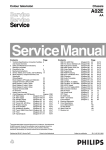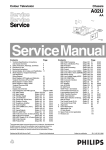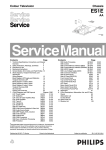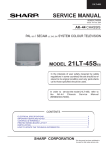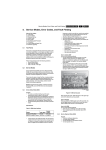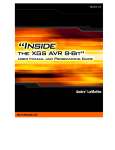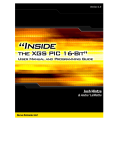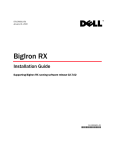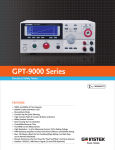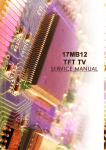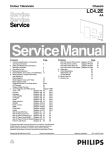Download Philips 32-REALFLAT CTV W-DBX STEREO - Service manual
Transcript
AK53 (D.O.C) SERVICE MANUAL RELEASE DATE: 22.03.2004 PREPARED BY: VESTEL ELECTRONICS Overall Block Diagram TABLE OF CONTENTS 1.INTRODUCTION.......................................................................................................................... 1 2.TUNER SPECIFICATION............................................................................................................. 1 3.IF/AUDIO&VIDEO SWITCHING/AD CONVERTER PART .............................................................. 2 (PNX3000 (CALLED AS MPIF)) ...................................................................................................... 2 4.DIGITAL TV PROCESSOR (PNX300X (CALLED AS ADOC))........................................................ 3 5.SOUND OUTPUT STAGE WITH TDA7480L ................................................................................. 4 6.VERTICAL OUTPUT STAGE WITH STV9379FA& TDA8177F....................................................... 4 7.VIDEO OUTPUT AMPLIFIER TDA6108JF .................................................................................... 4 8.POWER SUPPLY PART .............................................................................................................. 4 9.SERIAL ACCESS 64K EEPROM.................................................................................................. 5 10.HEADPHONE AMPLIFIER STAGE............................................................................................. 5 11.SAW FILTER SPECIFICATION .................................................................................................. 6 12.IC DESCRIPTIONS .................................................................................................................... 6 12.1.TDA6108JF (IC900)............................................................................................................. 7 12.1.1.General Description ....................................................................................................... 7 12.1.2.Features ........................................................................................................................ 7 12.1.3.Pinning .......................................................................................................................... 7 12.2.HT48RA0A.......................................................................................................................... 8 12.2.1.General Description ....................................................................................................... 8 12.2.2.Features ........................................................................................................................ 8 12.2.3.Pin Descriptions ............................................................................................................. 8 12.3.PNX3000 (IC400) ................................................................................................................. 9 12.3.1.General Description ....................................................................................................... 9 12.3.2.Features ........................................................................................................................ 9 12.4.CS51033 (IC 104) ...............................................................................................................13 12.4.1.General Description ......................................................................................................13 12.4.2.Features .......................................................................................................................13 12.4.3.Pin Description .............................................................................................................13 12.5.SDRAM 64MBIT (IC315) .....................................................................................................14 12.5.1.General Description ......................................................................................................14 12.5.2.Features .......................................................................................................................14 12.5.3.Pin Description .............................................................................................................14 12.6.FLASH (IC 314) ..................................................................................................................15 12.6.1.General Description ......................................................................................................15 12.6.2.Features .......................................................................................................................15 12.6.3.Pin/Ball Descriptions .....................................................................................................16 12.7.NE56610-29 (RESET IC) (IC 316)........................................................................................18 12.7.1.General Description ......................................................................................................18 12.7.2.Features .......................................................................................................................18 12.7.3.Pin Description .............................................................................................................18 12.8.STS5PF30L (IC105) ............................................................................................................19 12.8.1.Description ...................................................................................................................19 12.8.2.Features .......................................................................................................................19 12.9.PNX300X (IC313)................................................................................................................20 12.9.1.General Description of the Digital One Chip System........................................................20 12.9.2.Features of the ADOC Processor...................................................................................21 12.10.M24C64WBN6 (IC309) ......................................................................................................26 12.10.1.Features .....................................................................................................................26 12.10.2.Description .................................................................................................................26 12.11.TDA7480L (IC401,IC402) ..................................................................................................27 12.11.1.Description .................................................................................................................27 12.11.2.Features .....................................................................................................................27 12.11.3.Pin Functions ..............................................................................................................27 12.12.LM7808 (IC803) ................................................................................................................27 12.12.1.Description .................................................................................................................27 12.12.2.Features .....................................................................................................................27 12.13.TDA8177F & STV9379FA (IC100) .....................................................................................28 i AK53 D.O.C. Service Manual 22/03/2004 12.13.1.Description .................................................................................................................28 12.13.2.Features .....................................................................................................................28 12.13.3.Pin connections...........................................................................................................28 12.13.4.Block Diagram ............................................................................................................28 12.14.TCET1102G (IC801)..........................................................................................................29 12.14.1.Description .................................................................................................................29 12.14.2.Applications ................................................................................................................29 12.14.3.Features .....................................................................................................................29 12.15.MC44608 (IC804) ..............................................................................................................30 12.15.1.Description .................................................................................................................30 12.15.2.General Features ........................................................................................................30 12.15.3.Pin Connections ..........................................................................................................30 12.16.TL431 (Q816) ...................................................................................................................32 12.16.1.Description .................................................................................................................32 12.16.2.Features .....................................................................................................................32 12.16.3.Pin Configurations .......................................................................................................32 12.17.TFMS5360 ........................................................................................................................32 12.17.1.Description .................................................................................................................32 12.17.2.Features .....................................................................................................................32 13.AK53 CHASSIS MANUAL ADJUSTMENTS PROCEDURE ........................................................33 13.1.PRELIMINARY ...................................................................................................................33 13.2.SYSTEM VOLTAGE ADJUSTMENTS..................................................................................33 13.3.AFC ADJUSTMENTS .........................................................................................................33 13.4.FOCUS ADJUSTMENTS.....................................................................................................33 13.5.SCREEN ADJUSTMENT (VG2 ALIGNMENT) ......................................................................33 13.6.AGC (AUTOMATIC GAIN CONTROL).................................................................................33 14.AK53 CHASSIS PRODUCTION SERVICE MODE ADJUSTMENTS ............................................34 14.1.OPTIONS ...........................................................................................................................34 14.2.GEOMETRY .......................................................................................................................36 14.2.1.EW ALIGNMENT..........................................................................................................36 14.3.VIDEO ALIGNMENTS .........................................................................................................44 14.3.1.VIDEO ADJUST............................................................................................................44 14.3.1.1.WHITE DRIVE ........................................................................................................45 14.3.1.2.MIN BRIGHTNESS .................................................................................................45 14.3.1.3.MIN CONTRAST ....................................................................................................45 14.3.2.COLOR ADJUSTMENT.................................................................................................46 14.3.2.1.Y DEL SEC BG, Y DEL SEC DK, Y DEL SEC L, Y DEL SEC AV:.............................46 14.3.2.2.Y DEL PAL BG, Y DEL PAL DK, Y DEL PAL I, Y DEL PAL M, Y DEL PAL AV : .......46 14.3.2.3.VIDDEC QTHR, VIDDEC STHR ..............................................................................46 14.4.SOUND RELATED OPTIONS ..............................................................................................47 14.5.FACTORY SETTINGS ........................................................................................................48 15.MENU LANGUAGES ................................................................................................................49 16.BLOCK DIAGRAM ....................................................................................................................50 17.CIRCUIT DIAGRAMS................................................................................................................51 ii AK53 D.O.C. Service Manual 22/03/2004 1.INTRODUCTION 11AK53 is a 100Hz color television DIGITAL ONE CHIP SYSTEM (DOC) capable of driving 28”4:3/16:9 SF/RF, 29”4:3 real flat, 32” 16:9 SF/RF, 33”4:3 and 34‘ 4:3 real flat picture tubes. The chassis is capable of operation in PAL, SECAM, NTSC (playback) color standards and multiple transmission standards as B/G, D/K, I/I’, and L/L´. Sound system output is supplying 2x10W (10%THD) for left and right outputs of 8ohm speakers. TV supports the level 1.5 teletext standard. It is possible to decode transmissions including high graphical data. The chassis is equipped with two full EuroScarts, one SCART for AV input/output, one front-AV input, one back-AV input, one headphone output, one SVHS input (via SCART and SVHS connector), two external speaker outputs (left and right), one audio line output. 2.TUNER SPECIFICATION The hardware and software of the TV is suitable for tuners, supplied by different companies, which are selected from the Service Menu. These tuners can be combined VHF, UHF tuners suitable for CCIR 2 systems B/G, H, L, L´, I/I´, and D/K. The tuning is available through the digitally controlled I C bus (PLL). Below you will find info on one of the Tuners in use. General description of UV1316 MK3(Philips) /CTF55XX (Thomson): UV1316 MK3 (Philips) /CTF55XX (Thomson) tuners, which are designed to meet a wide range of applications are PLL tuners; It is a combined VHF, UHF tuner suitable for CCIR systems B/G, H, L, L’, I and I’. The low IF output impedance has been designed for direct drive of a wide variety of SAW filters with sufficient suppression of triple transient. Features of Tuner: 1. Those tuners are small sized UHF/VHF tuners 2. Systems CCIR: B/G, H, L, L’, I and I’; OIRT: D/K 2 3. Digitally controlled (PLL) tuning via I C-bus 4. Off-air channels, S-cable channels and Hyperband 5. World standardized mechanical dimensions and world standard pinning 6. Compact size 7. Complies to “CENELEC EN55020” and “EN55013” Pinning: 1. Gain control voltage (AGC) 2. Tuning voltage 3. I²C-bus address select 4. I²C-bus serial clock 5. I²C-bus serial data 6. Not connected 7. PLL supply voltage 8. ADC input 9. Tuner supply voltage* 10. Symmetrical IF output 1 11. Symmetrical IF output 2 : 4.0V, Max: 4.5V : : : Max: 5.5V Min:-0.3V, Max: 5.5V Min:-0.3V, Max: 5.5V : 5.0V, Min: 4.75V, Max: 5.5V : 33V, Min: 30V, Max: 35V *33V is obtained from FBT of large signal board. 1 AK53 D.O.C. Service Manual 22/03/2004 3.IF/AUDIO&VIDEO SWITCHING/AD CONVERTER PART (PNX3000 (CALLED AS MPIF)) MPIF IC consists of following OVERALL blocks; (1)-Video/Audio switching (2)-IF processing (3)-A/D conversion for digital TV (DTV) processor (ADOC-PNX300X) Main building blocks: _ Vision PLL-IF, auto-calibrated, selectable IF frequency, 4 selectable AGC time constants, built-in sound trap and selectable group delay. The demodulated CVBS signal is fed outside for use with SCART. _ Synthesizer mode, meant for down mixing of DTV signals to a suitable 2nd IF which can be handled by a digital DTV decoder. Using a suitable SAW filter at the input the synthesizer mode can also be used to downmix FM radio frequencies from the Tuner to a suitable 2nd IF frequency for the FM demodulator. _ Two Video IF inputs, selectable by internal switch to enable use of optimized SAW filters _ Sound QSS IF, demodulated 2nd SIF can be either from SIF input (QSS) or Video IF (intercarrier). The Sound IF also contains an AM demodulator for SECAM L/L' _ CVBS and Y/C crossbar switch, with 2 video outputs for further processing in the Digital TV Signal Processor after A/D conversion and 2 selectable video outputs which are available on output pins for external connections 2 AK53 D.O.C. Service Manual 22/03/2004 _ Two YUV / RGB inputs, which can handle also YPrPb and sync on Y for DVD players Also 2Fh YUV / RGB signals can be handled by the A/D converters. _ An audio stereo crossbar switch with two outputs (one stereo, one stereo or mono) for further processing in the processor after A/D conversion and three stereo outputs for external connections. Extra inputs are provided to enable also the selection of demodulated RF sound (mono, NICAM, 2CS) from the Digital TV Signal Processor for use on external connections. _ Low pass filtering and A/D conversion. The audio and video sampling clocks use the same reference so it is possible to interleave video and audio data into one serial data stream. _ For control, I 2 C control is built-in with a selectable address. _ Auxiliary building blocks which perform some functions which have typical better performance in analogue design environment than in digital and are used by the Digital TV Signal Processor: - Reference voltage for vertical deflection and audio ADC's - Voltage to current conversion of the E/W The set-up with an analogue and a digital part has the following advantages: _ High frequent parts (IF) can be included in the concept _ Less A/D and D/A converters needed for source switching _ Better performance for AD converters (realized in analogue design environment, more accurate, less tolerance) _ Critical items like reference voltages can be realized in the analogue environment 4.DIGITAL TV PROCESSOR (PNX300X (CALLED AS ADOC)) The DOC system serves the TV functionality for small signal processing of audio, video, VBI services, graphics and control. This chip implements all TV functions in digital technology. PNX300X is the digital TV processor which consists of; ? TV video processor ? TV deflection processor ? TV audio processor ? TV microcontroller As it is shown in the below block diagram ADOC gets the digital signal which is converted by MPIF and processed in its own blocks and controls the overall system by I2C and the software programme is downloaded into a flash memory which tells microcontroller within ADOC about the software management and the output of ADOC turns into RGB, Main/Headphone audio right/left. Then RGB output of ADOC is processed into a RGB preamplifier circuit to get enough gain for the video output amplifier TDA6108JF (in CRT board) Highlight points of ADOC: (1)-Digital (I2D) data link is connected from MPIF to ADOC with a swing of about 300mV. The data rate is 594Mbit/s. (2)-Only one crystal is used in overall system which is 13.5MHZ. 3 AK53 D.O.C. Service Manual 22/03/2004 Functional block diagram of ADOC: 5.SOUND OUTPUT STAGE WITH TDA7480L The TDA7480L is an audio class-D amplifier assembled in Power DIP package specially designed for high efficiency applications mainly for TV and Home Stereo sets. Mute stand-by function of the audio amplifier can be described as the following; the pin 12 (MUTE/STAND-BY) controls the amplifier status by two different thresholds, referred to ground. When Vpin 12 voltage is lower than 0.7V the amplifier is in Stand-by mode and the final stage generators are off. When Vpin 12 is higher than 4V, the amplifier is in play mode. The TDA7480L is a 10W+10W stereo sound amplifier with mute/stand-by facility. MUTE control signal coming from microcontroller (when it is at high level) activates the mute function. IC is muted when mute pin is at low level (pin12). MUTE pin can also be activated via an external pop-noise circuitry in order to eliminate pop noise when TV is turned off. Just after the TV is turned off, this circuit switches the IC to stand-by mode by pulling the mute pin voltage to ground. 6.VERTICAL OUTPUT STAGE WITH STV9379FA& TDA8177F The IC STV9379FA& TDA8177F is the vertical deflection booster circuit. Two supply voltages, +14V and –14V are needed to scan the inputs VERT+ and VERT-, respectively. And a third supply voltage, +60V for the flyback limiting is needed. The vertical deflection coil is connected in series between the output and feedback to the input. 7.VIDEO OUTPUT AMPLIFIER TDA6108JF The TDA6108JF includes three video output amplifiers is intended to drive the three cathodes of a color picture tube. 8.POWER SUPPLY PART In Large Signal Board The DC voltages required at various parts of the chassis are provided by an SMPS transformer controlled by the IC MC44608, which is designed for driving, controlling and protecting switching transistor of SMPS. The transformer generates 135V for FBT input, +/-14V for audio amplifier, 8V, 12V, V8Stby ( needed for step down converted for small signal board) and 5V supplies for other different parts of the chassis. 4 AK53 D.O.C. Service Manual 22/03/2004 An optocoupler is used to control the regulation of line voltage and stand-by power consumption. There is a regulation circuit in secondary side. This circuit produces a control voltage according to the changes in 135V DC voltage, via an optocoupler (TCET 1102G) to pin3 of the IC. During the switch on period of the transistor, energy is stored in the transformer. During the switch off period energy is fed to the load via secondary winding. By varying switch-on time of the power transistor, it controls each portion of energy transferred to the second side such that the output voltage remains nearly independent of load variations. In Small Signal Board V8Stby and +5V is switched by a discrete circuit to make power consumption effective. ? When supply switch port of ADOC IC is HIGH +5V ? 3.3V via IC103 regulator ? When supply switch port of ADOC IC is LOW V8Stby ? 3.3V via IC103 regulator V8Stby is used to get +5V, which is available in Stby. Supply Voltages Available/Not-Available In Stand-by, IC Requirement, Supply Location Supply 135V (B+) In Stby available? Where? For Which ? NO large signal board FBT NOTE depends on CRT 14V-A NO (-)14V -A NO 14V 8V NO NO 5V V8stby 1.8V 3.3V NO YES YES YES 12V 5V Vert Sup+ (14V) Vert Sup- (14V) 33V NO YES NO NO large signal board IC401,IC402(Audio amplifier) large signal board IC401,IC402(Audio amplifier) large signal board Horizontal drive transistor small signal board IC400 (MPIF)/Headphone discrete circuit/RGB pre amplifiers/audio saw filter(Z401) small signal board IC400 (MPIF),Tuner(TU200,TU850) large signal board Step down IC and for s+5V small signal board IC313 (ADOC) small signal board IC313 (ADOC),IC309(EEPROM),IC316(Reset IC) small signal board CRT board (IC900) small signal board LED/IR large signal board Vertical IC (IC100) large signal board Vertical IC (IC100) NO large signal board Tuner (TU200,TU850) Important Microcontroller Ports For Supplying Port On/Off On/Off State low high Function normal operation stand by mode 9.SERIAL ACCESS 64K EEPROM M24C64WBN6, is the 64Kbit electrically erasable programmable memory. The memory is compatible 2 with the I C standard, two wire serial interface, which uses a bi-directional data bus and serial clock. 10.HEADPHONE AMPLIFIER STAGE This stage is designed with discrete components (no IC is used for this purpose) 5 AK53 D.O.C. Service Manual 22/03/2004 11.SAW FILTER SPECIFICATION Two groups of saw filters are used from EPCOS For picture (Z400) ? Pal Secam BG DK L L’?K3953M ? Pal Secam BG I I’ ?K3953M For sound(Z401) ? Pal Secam BG DK L L’?K9656M ? Pal Secam BG I I’ ?K9356 For sound saw filter it needs to be switched between L’ and other standards for K3953M, a port signal coming from PNX300X(ADOC) called SEL_L/L’ is used for this purpose to make pin2 of audio saw filter ground or not. port state Q404 SEL_L/L' High Shorted to ground SEL_L/L' Low open Standard L' BG,DK,I,L Pin Configuration Pin No 1 2 3 4 5 Definition Input Input - ground Chip carrier - ground Output Output Maximum ratings for saw filters Operable temperature range Storage temperature range DC voltage AC voltage TA Tstg VDC Vpp –25/+65 °C 12.IC DESCRIPTIONS In following chapters you can find details of ICs used in the chassis and the SS B(Small signal board) TDA6108JF PNX3000 SDRAM 64MBIT NE56610-29 PNX300X TDA7480L TDA8177&STV9379FA MC44608 TFMS5360 HT48RA0A CS51033 FLASH 32 MBIT STS5PF30L M24C64WBN6 LM7808 TCET1102G TL431 6 AK53 D.O.C. Service Manual 22/03/2004 12.1.TDA6108JF (IC900) 12.1.1.General Description The TDA6108JF includes three video output amplifiers in one plastic DIL-bent-SIL 9-pin medium power (DBS9MPF) package (SOT111-1), using high-voltage DMOS technology, and is intended to drive the three cathodes of a color CRT directly. To obtain maximum performance, the amplifier should be used with blackcurrent control. 12.1.2.Features • Typical bandwidth of 9.0 MHz for an output signal of 60 V (p-p) • High slew rate of 1850 V/ms • No external components required • Very simple application • Single supply voltage of 200 V • Internal reference voltage of 2.5 V • Fixed gain of 51 • Black-Current Stabilization (BCS) circuit • Thermal protection 12.1.3.Pinning SYMBOL Vi(1) Vi(2) Vi(3) GND Iom VDD Voc(3) Voc(2) Voc(1) PIN 1 2 3 4 5 6 7 8 9 DESCRIPTION inverting input 1 inverting input 2 inverting input 3 ground (fin) black current measurement output supply voltage cathode output 3 cathode output 2 cathode output 1 7 AK53 D.O.C. Service Manual 22/03/2004 12.2.HT48RA0A 12.2.1.General Description The HT48RA0A is an 8-bit high performance RISC-like microcontroller specifically designed for multiple I/O product applications. The device is particularly suitable for use in products such as infrared remote controllers and various subsystem controllers. A HALT feature is included to reduce power consumption. 12.2.2.Features • Operating voltage: 2.2V~3.6V • Ten bidirectional I/O lines • Six Schmitt trigger input lines • One carrier output (1/2 or 1/3 duty) • On-chip crystal and RC oscillator • Watchdog Timer • 1K_14 program EPROM • 32_8 data RAM • HALT function and wake-up feature reduce power consumption • 62 powerful instructions • Up to 1_s instruction cycle with 4MHz system clock • All instructions in 1 or 2 machine cycles • 14-bit table read instructions • One-level subroutine nesting • Bit manipulation instructions • 20-pin/24-pin SOP package 12.2.3.Pin Descriptions Pin Name PB0, PB1 I/O I/O Code Option Wake-up or None PC0/REM O Level or Carrier VDD OSC2 OSC1 I/O Crystal or RC VSS RES PB2~PB7 I I PA0~PA7 I/O Wake-up or None - Description 2-bit bidirectional input/output lines with pull-high resistors. Each bit can be determined as NMOS output or Schmitt trigger input by software instructions. Each bit can also be configured as wake-up input by code option. Level or carrier output pin PC0 can be set as CMOS output pin or carrier output pin by code option. Positive power supply OSC1, OSC2 are connected to an RC network or a crystal (determined by code option) for the internal system clock. In the case of RC operation, OSC2 is the output terminal for 1/4 system clock (NMOS open drain output). Negative power supply, ground Schmitt trigger reset input. Active low. 6-bit Schmitt trigger input lines with pull-high resistors. Each bit can be configured as a wake-up input by code option. Bidirectional 8-bit input/output port with pull-high resistors. Each bit can be determined as NMOS output or Schmitt trigger input by software instructions. 8 AK53 D.O.C. Service Manual 22/03/2004 12.3.PNX3000 (IC400) 12.3.1.General Description The PNX3000 is an analog front end for digital video processors. It contains an IF circuit for both analog and digital broadcast signals, and input selectors and A to D converters for analog video and audio signals. The digital output signals are made available via three serial data links. The IC has a supply voltage of 5V. The supply voltage of the analog audio part can be 5V or 8V, depending on the maximum signal amplitudes that are required. 12.3.2.Features • Multi-standard vision IF circuit with alignment-free PLL demodulator without external components • Internal (switchable) time-constant for the IF-AGC circuit • DTV IF circuit for gain control of digital broadcast TV signals. • Sound IF amplifier with separate AGC circuit for quasi split sound • IF circuit can also be used for intercarrier sound • Analog demodulator for AM sound • Integrated sound trap and group delay correction • Video ident function detects the presence of a video signal • Video source selector with 4 external CVBS or YC inputs and 2 analog CVBS outputs with independent source selection for each output • Two linear inputs for 1fH or 2fH RGB signals with source selector. The RGB signals are converted to YUV before A to D conversion. Both inputs can also be used as YPB PR input for DVD or set top box • Integrated anti-alias filters for video A to D converters • Four 10-bit video A to D converters for the conversion of CVBS, YC, YUV and down mixed sound IF signals • Up to three different A to D converted video channels are simultaneous available (e.g. CVBS and YC and YUV) • Audio source selector with 5 stereo inputs for analog audio and two microphone inputs • Two microphone amplifiers with adjustable gain • Three analog audio outputs for SCART and Line out with independent source selection for each output • Four 1-bit audio sigma delta A to D converters for the conversion of audio and microphone signals • Three serial data link transmitters for interfacing with the digital video processor. The bit rate is 594 Mbits/sec per data link • Voltage to current converter for driving of external East-West power amplifier 2 • I C-bus transceiver with selectable slave address and maskable interrupt output 9 AK53 D.O.C. Service Manual 22/03/2004 SYMBOL PIN DESCRIPTION CVBS2 VAUDO VAUDS CVBS/Y3 C3 GND_VSW BGDEC CVBS/Y4 C4 fuse GND_FILT CVBS_DTV RREF VCC_FILT YCOMB CCOMB AMEXT TESTPIN3 CVBSOUTA VDEFLO VDEFLS CVBSOUTB fuse TESTPIN2 R1/PR1 /V1 G1/Y1/Y1 B1/PB1 /U1 VCC_RGB GND_RGB R2/PR2 /V2 G2/Y2/Y2 B2/PB2 /U2 fuse GND_VADC VCC_VADC EWVIN EWIOUT REW ADR XREF fuse IRQ SDA SCL HV_SEC HV_PRIM VD2V5 GND_DIG VCC_DIG STROBE3N STROBE3P DATA3N DATA3P fuse STROBE2N STROBE2P DATA2N 1 2 3 4 5 6 7 8 9 CVBS2 input DC output voltage for supply of audio DACs in digital decoder sense voltage for audio DACs supply external CVBS/Y3 input external CHROMA3 input ground video switch bandgap decoupling external CVBS/Y3 input external CHROMA3 input fused lead ground filters input for CVBS encoded signal from DTV decoder reference current input supply voltage filters (5V) Y signal from 3D Comb filter C signal from 3D Comb filter external AM mono input test pin 3 (leave open) CVBS or Y+CHROMA output A DC output voltage for supply of deflection DACs in digital decoder sense voltage for deflection DACs supply CVBS or Y+CHROMA output B fused lead test pin 2 (connect to ground) R1/PR1 /V1 input G1/Y1/Y1 input B1/PB1 /U1 input supply voltage RGB matrix (5V) ground RGB matrix R2/PR2 /V2 input G2/Y2/Y2 input B2/PB2 /U2 input fused lead ground video ADCs supply voltage video ADCs (5V) East-West input voltage East-West output current East-West voltage to current conversion resistor I2C address selection XTAL reference frequency input fused lead interrupt request output I2C serial data input/output I2C serial clock input horizontal and vertical sync input for secondary video channel horizontal and vertical sync input for primary video channel decoupling of internal digital supply voltage digital ground digital supply voltage (5V) strobex negative datalink3 strobex positive datalink3 data positive datalink3 data positive datalink3 fused lead strobex negative datalink2 strobex positive datalink2 data positive datalink2 10 11 12 13 14 15 16 17 18 19 20 21 22 23 24 25 26 27 28 29 30 31 32 33 34 35 36 37 38 39 40 41 42 43 44 45 46 47 48 49 50 51 52 53 54 55 56 57 10 AK53 D.O.C. Service Manual 22/03/2004 DATA2P GND_I2D STROBE1N STROBE1P DATA1N DATA1P VCC_I2D SCART2R SCART2L LINER LINEL SCART1R SCART1L fuse DSNDR2 DSNDL2 DSNDR1 DSNDL1 GND_AADC VCC_AADC fuse R4 L4 R3 L3 R2 L2 R1 L1 GND2_ASW VCC2_ASW VAADCREF VAADCN VAADCP MIC2N MIC2P MIC1N MIC1P fuse GND1_ASW VCC1_ASW SIFINP SIFINN SIFAGC DTVIFAGC DTVIFINP DTVIFINN TUNERAGC fuse VIFINP VIFINN DTVIFPLL VCC_IF VIFPLL GND1_IF 2NDSIFEXT 2NDSIFAGC GND2_IF DTVOUTP 58 59 60 61 62 63 64 65 66 67 68 69 70 71 72 73 74 75 76 77 78 79 80 81 82 83 84 85 86 87 88 89 90 91 92 93 94 95 96 97 98 99 100 101 102 103 104 105 106 107 108 109 110 111 112 113 114 115 116 data positive datalink2 ground datalinks strobex negative datalink1 strobex positive datalink1 data negative datalink1 data positive datalink1 supply voltage datalinks (5V) audio output for SCART 2 right audio output for SCART 2 left audio line output right audio line output left audio output for SCART1 right audio output for SCART1 left fused lead audio signal from digital decoder right 2 audio signal from digital decoder left 2 audio signal from digital decoder right 1 audio signal from digital decoder left 1 ground audio ADCs supply voltage audio ADCs (5V) fused lead right input audio 4 left input audio 4 right input audio 3 left input audio 3 right input audio 2 left input audio 2 right input audio 1 left input audio 1 ground audio switch supply voltage audio switch (audio output buffers, 5V or 8V) decoupling of reference voltage for audio ADCs 0V reference voltage for audio ADCs (GND) full scale reference voltage for audio ADCs (5V) microphone input 2 neg microphone input 2 pos microphone input 1 neg microphone input 1 pos fused lead ground audio switch supply voltage audio switch (audio input buffers, 5V or 8V) sound IF input positive sound IF input negative control voltage for SIF AGC control voltage for DTV IF AGC DTV IF input positive DTV IF input negative tuner AGC output fused lead vision IF input positive vision IF input negative loop filter DTVIF PLL demodulator supply voltage IF circuit (5V) loop filter VIF PLL demodulator ground IF circuit 2ndSIF input 2ndSIF AGC capacitor ground IF circuit DTV output positive 11 AK53 D.O.C. Service Manual 22/03/2004 DTVOUTN VCC_SUP fuse CVBSOUTIF GND_SUP VCC1_VSW CVBS0 TESTPIN1 VCC2_VSW CVBS1 R5 L5 117 118 119 120 121 122 123 124 125 126 127 128 DTV output negative supply of supply circuit (5V) fused lead CVBS output of IF circuit ground of supply circuit supply of video switch (5V) CVBS0 input (to be used for CVBS from IF part) test pin 1 (connect to ground) supply of video switch (5V) CVBS1 input right input audio 5 left input audio 5 Important pins need to be checked in case of troubleshooting Signal CVBS/RGB Input voltage CVBS Output voltage Maximum input audio voltage Maximum output audio voltage Measure Input pins Output pins Input pins Output pins Value 1Vpk-pk 2 Vpk-pk 2 Vrms 2 Vrms 12 AK53 D.O.C. Service Manual 22/03/2004 12.4.CS51033 (IC 104) 12.4.1.General Description The CS51033 is a switching controller for use in dc–dc converters. It can be used in the buck topology with a minimum number of external components. The CS51033 consists of a 1.0 A power driver for controlling the gate of a discrete P–channel transistor, fixed frequency oscillator, short circuit protection timer, programmable Soft Start, precision reference, fast output voltage monitoring comparator, and output stage driver logic with latch. The high frequency oscillator allows the use of small inductors and output capacitors, minimizing PC board area and systems cost. The programmable Soft Start reduces current surges at start up. The short circuit protection timer significantly reduces the PFET duty cycle to approximately 1/30 of its normal cycle during short circuit conditions. The CS51033 is available in an 8–Lead SO package. 12.4.2.Features • 1.0 A Totem Pole Output Driver • High Speed Oscillator (700 kHz max) • No Stability Compensation Required • Lossless Short Circuit Protection • 2.0% Precision Reference • Programmable Soft Start • Wide Ambient Temperature Range: Industrial Grade: –40°C to 85°C Commercial Grade: 0°C to 70°C 12.4.3.Pin Description PIN NUMBER 1 2 3 4 5 6 7 8 PIN SYMBOL VGATE PGND COSC GND VFB VCC CS VC FUNCTION Driver pin to gate of external PFET. Output power stage ground connection. Oscillator frequency programming capacitor. Logic ground. Feedback voltage input. Logic supply voltage. Soft Start and fault timing capacitor. Driver supply voltage. 13 AK53 D.O.C. Service Manual 22/03/2004 12.5.SDRAM 64MBIT (IC315) 12.5.1.General Description Please note that in the following explanation one of the SDRAM alternative is used. The K4S641632D is 67,108,864 bits synchronous high data rate Dynamic RAM organized as 4 x 1,048,576 words by 16 bits, fabricated with SAMSUNG¢s high performance CMOS technology. Synchronous design allows precise cycle control with the use of system clock I/O transactions are possible on every clock cycle. Range of operating frequencies, programmable burst length and programmable latencies allow the same device to be useful for a variety of high bandwidth, high performance memory system applications. 12.5.2.Features • JEDEC standard 3.3V power supply • LVTTL compatible with multiplexed address • Four banks operation • MRS cycle with address key programs -. CAS latency (2 & 3) -. Burst length (1, 2, 4, 8 & Full page) -. Burst type (Sequential & Interleave) • All inputs are sampled at the positive going edge of the system clock • Burst read single-bit write operation • DQM for masking • Auto & self refresh • 64ms refresh period (4K cycle) 12.5.3.Pin Description PIN CLK CS NAME System clock Chip select CKE Clock enable A0 ~ A11 Address BA0 ~ BA1 Bank select address RAS Row address strobe CAS Column address strobe WE Write enable L(U)DQM Data input/output mask DQ0 ~ 15 VDD/VSS VDDQ/VSSQ Data input/output Power supply/ground Data output power/ground N.C/RFU No connection /reserved for future use INPUT FUNCTION Active on the positive going edge to sample all inputs. Disables or enables device operation by masking or enabling all inputs except CLK, CKE and L(U)DQM Masks system clock to freeze operation from the next clock cycle. CKE should be enabled at least one cycle prior to new command. Disable input buffers for power down in standby. Row/column addresses are multiplexed on the same pins. Row address : RA0 ~ RA11, Column address : CA0 ~ CA7 Selects bank to be activated during row address latch time. Selects bank for read/write during column address latch time. Latches row addresses on the positive going edge of the CLK with RAS low. Enables row access & precharge. Latches column addresses on the positive going edge of the CLK with CAS low. Enables column access. Enables write operation and row precharge. Latches data in starting from CAS, WE active. Makes data output Hi-Z, tSHZ after the clock and masks the output. Blocks data input when L(U)DQM active. Data inputs/outputs are multiplexed on the same pins. Power and ground for the input buffers and the core logic. Isolated power supply and ground for the output buffers to provide improved noise immunity. This pin is recommended to be left No Connection on the device. 14 AK53 D.O.C. Service Manual 22/03/2004 12.6.FLASH (IC 314) 12.6.1.General Description The MT28F128J3 is a nonvolatile, electrically block-erasable (Flash), programmable memory containing 134,217,728 bits organized as 16,777,218 bytes (8 bits) or 8,388,608 words (16 bits). This 128Mb device is organized as one hundred twenty-eight 128KB erase blocks. The MT28F640J3 contains 67,108,864 bits organized as 8,388,608 bytes (8 bits) or 4,194,304 words (16 bits). This 64Mb device is organized as sixty-four 128KB erase blocks. Similarly, the MT28F320J3 contains 33,554,432 bits organized as 4,194,304 bytes (8 bits) or 2,097,152 words (16 bits). This 32Mb device is organized as thirty-two 128KB erase blocks. These three devices feature in-system block locking. They also have common Flash interface (CFI) that permits software algorithms to be used for entire families of devices. The software is deviceindependent, JEDEC ID-independent with forward and backward compatibility. Additionally, the scalable command set (SCS) allows a single, simple software driver in all host systems to work with all SCS-compliant Flash memory devices. The SCS provides the fastest system/device data transfer rates and minimizes the device and system-level implementation costs. To optimize the processor-memory interface, the device accommodates VPEN, which is switchable during block erase, program, or lock bit configuration, or hard-wired to VCC, depending on the application. VPEN is treated as an input pin to enable erasing, programming, and block locking. When VPEN is lower than the VCC lockout voltage (VLKO), all program functions are disabled. Block erase suspend mode enables the user to stop block erase to read data from or program data to any other blocks. Similarly, program suspend mode enables the user to suspend programming to read data or execute code from any unsuspended blocks. VPEN serves as an input with 2.7V, 3.3V, or 5V for application programming. VPEN in this Q-Flash _ family can provide data protection when connected to ground. This pin also enables program or erase lockout during power transition. Micron’s even-sectored Q-Flash devices offer individual block locking that can lock and unlock a block using the sector lock bits command sequence. Status (STS) is a logic signal output that gives an additional indicator of the internal state machine (ISM) activity by providing a hardware signal of both status and status masking. This status indicator minimizes central processing unit (CPU) overhead and system power consumption. In the default mode, STS acts as an RY/BY# pin. When LOW, STS indicates that the ISM is performing a block erase, program, or lock bit configuration. When HIGH, STS indicates that the ISM is ready for a new command. Three chip enable (CE) pins are used for enabling and disabling the device by activating the device’s control logic, input buffer, decoders, and sense amplifiers. BYTE# enables the device to be used in x8 or x16 read/write mode; BYTE# = 0 selects an 8-bit mode, with address A0 selecting between the LOW and HIGH byte, while BYTE# = 1 selects a 16-bit mode. When BYTE# = 1, A1 becomes the lowest-order address line with A0 being a no connect. RP# is used to reset the device. When the device is disabled and RP# is at Vcc, the standby mode is enabled. A reset time (t RWH) is required after RP# switches HIGH until outputs are valid. Likewise, the device has a wake time (t RS) from RP# high until writes to the command user interface (CUI) are recognized. When RP# is at GND, it provides write protection, resets the ISM, and clears the status register. A variant of the MT28F320J3 also supports the new security block lock feature for additional code security. This feature provides an OTP function for the device. (Contact factory for availability.) The MT28F320J3 and the MT28F640J3 are manufactured using the 0.18µm process technology, and the MT28F128J3 is manufactured using the 0.15µm process technology. 12.6.2.Features • x8/x16 organization • One hundred twenty-eight 128KB erase blocks (128Mb) Sixty-four 128KB erase blocks (64Mb) Thirty-two 128KB erase blocks (32Mb) •VCC, VCCQ, and VPEN voltages: 2.7V to 3.6V VCC operation 2.7V to 3.6V, or 5V VPEN application programming • Interface Asynchronous Page Mode Reads: 150ns/25ns or 120ns/25ns read access time (128Mb) 120ns/25ns or 115ns/25ns read access time (64Mb) 110ns/25ns read access time (32Mb) • Manufacturing ID (ManID) Intel® (0x89h) 15 AK53 D.O.C. Service Manual 22/03/2004 Micron® (0x2Ch) • Industry-standard pinout • Inputs and outputs are fully TTL-compatible • Common Flash Interface (CFI) and Scalable Command Set • Automatic write and erase algorithm • 5.6µs-per-byte effective programming time using write buffer • 128-bit protection register 64-bit unique device identifier 64-bit user-programmable OTP cells • Enhanced data protection feature with VPEN = VSS Flexible sector locking Sector erase/program lockout during power transition •Security OTP block f feature Permanent block locking (Contact factory for availability) • 100,000 ERASE cycles per block • Automatic suspend options: Block Erase Suspend-to-Read Block Erase Suspend-to-Program Program Suspend-to-Read 12.6.3.Pin/Ball Descriptions 56-PIN TSOP NUMBERS 55 64-BALL FBGA NUMBERS G8 14, 2, 29 SYMBOL TYPE WE# Input B4, B8, H1 CE0, CE1, CE2 Input 16 D4 RP# Input 54 F8 OE# Input 32, 28, 27, 26, 25, 24, 23, 22, 20, 19, 18, 17, 13, 12, 11, 10, 8, 7, 6, 5, 4, 3, 1, 30 31 G2, A1, B1, C1, D1, D2, A2, C2, A3, B3, C3, D3, C4, A5, B5, C5, D7, D8, A7, B7, C7, C8, A8, G1 F1 A0 _ A21/ (A22) (A23) Input BYTE# Input 15 A4 VPEN Input DESCRIPTION Write Enable: Determines if a given cycle is a WRITE cycle. If WE# is LOW, the cycle is either a WRITE to the command execution logic (CEL) or to the memory array. Addresses and data are latched on the rising edge of the WE# pulse. Chip Enable: Three CE pins enable the use of multiple Flash devices in the system without requiring additional logic. The device can be configured to use a single CE signal by tying CE1 and CE2 to ground and then using CE0 as CE. Device selection occurs with the first edge of CE0, CE1, or CE2 (CEx) that enables the device. Device deselection occurs with the first edge of CEx that disables the device (see Table 4 on page 14). Reset/Power-Down: When LOW, RP# clears the status register, sets the ISM to the array read mode, and places the device in deep power-down mode. All inputs, including CEx, are “Don’t Care,” and all outputs are High-Z. RP# must be held at VIH during all other modes of operation. Output Enables: Enables data output buffers when LOW. When OE# is HIGH, the output buffers are disabled. Address inputs during READ and WRITE operations. A0 is only used in x8 mode and will be a NC in x16 mode (the input buffer is turned off when BYTE = HIGH). A22 (pin 1, ball A8) is only available on the 64Mb and 128Mb devices. A23 (pin 30, ball G1) is only available on the 128Mb device. BYTE# low places the device in the x8 mode. BYTE# high places the device in the x16 mode and turns off the A0 input buffer. Address A1 becomes the lowest order address in x16 mode. Necessary voltage for erasing blocks, programming data, or configuring lock bits. Typically, VPEN is connected to VCC. When VPEN _ VPENLK, this pin enables hardware write protect. 16 AK53 D.O.C. Service Manual 22/03/2004 33, 35, 38, 44, 46, 49, 34, 36, 39, 45, 49, 51, 36, 39, 41, 47, 50, 52 53 40, 51, 41, 34, 45, F2, E2, G3, E4, E5, G5, G6, H7, E1, E3, F3, F4, F5, H5, G7, E7 DQ0– DQ15 Input/ Output Data I/O: Data output pins during any READ operation or data input pins during a WRITE. DQ8–DQ15 are not used in byte mode (BYTE = LOW). E8 STS Output 43 G4 V CCQ Supply 9, 37 21, 42, 48 56 H3, A6 B2, H4, H6 H8 V CC V SS NC Supply Supply — — B6, C6, D5, D6, E6, F6, F7, H2 DNU — Status: Indicates the status of the ISM. When configured in level mode (default), STS acts as a RY/BY# pin. When configured in its pulse mode, it can pulse to indicate program and/or erase completion. Tie STS to V CCQ through a pull-up resistor. V CCQ controls the output voltages. To obtain output voltage compatible with system data bus voltages, connect VCCQ to the system supply voltage. Power Supply: 2.7V to 3.6V. Ground. No Connect: These may be driven or left unconnected. Pin 1 and ball A8 are NCs on the 32Mb device. Pin 30 and ball G1 are NCs on the 32Mb and 64Mb devices. Do Not Use: Must float to minimize noise. 17 AK53 D.O.C. Service Manual 22/03/2004 12.7.NE56610-29 (RESET IC) (IC 316) 12.7.1.General Description The NE56610-29 is a family of devices designed to generate a reset signal for a variety of microprocessor and logic systems. Accurate reset signals are generated during momentary power interruptions or when ever power supply voltages sag to intolerable levels. The NE56610-29 incorporates an internal timer to provide reset delay and ensure proper operating voltage has been attained. An Open Collector output topology provides adaptability for a wide variety of logic and microprocessor systems. SOT23-5 surface mount package is used. 12.7.2.Features • 3.3V operating voltage (VDDE) • SOT23-5 surface mount package • Offered in reset thresholds 2.9 V DC • Internal reset delay timer is 50ms 12.7.3.Pin Description PIN NUMBER 1 2 3 4 5 SYMBOL M/R DESCRIPTION Manual Reset input. Connect to ground when not using. SUB GND VOUT Vcc Substrate pin. Connect to ground. Ground Reset HIGH output pin Positive power supply input 18 AK53 D.O.C. Service Manual 22/03/2004 12.8.STS5PF30L (IC105) 12.8.1.Description STS5PF30L is a Power MOSFET. 12.8.2.Features • TYPICAL RDS(on) = 0.070 ? ? • STANDARD OUTLINE FOR EASY AUTOMATED SURFACE MOUNT ASSEMBLY • LOW THRESHOLD DRIVE TYPE STS5PF30L VDSS 30V RDS(on) <0.080 O ID 5A 19 AK53 D.O.C. Service Manual 22/03/2004 12.9.PNX300X (IC313) This IC is the heart of the TV set for small signal processing. 12.9.1.General Description of the Digital One Chip System DOC Hardware The Digital One Chip System (DOC) is a system concept based on a digital processor for double-scan TV receivers. It is a global, multi-standard system primarily designed for the reception and processing of analog broadcast signals. The DOC system serves the TV functionality for small signal processing of audio, video, VBI services, graphics and control. An integrated MIPS 1910 processor runs the DOCware software stack. The Digital One Chip DOCware software is stored in a non-volatile external memory, normally flash memory. The following figure shows the hardware system architecture of a TV chassis based on the DOC system. The dual stream architecture of the DOC system allows audio and video processing of two A/V sources simultaneously. The two video streams can be displayed in several programmable ways (main screen, PIP or DW). The two audio streams are audible via the TV loudspeakers and/or the headphones. If two TV broadcast signals have to be processed simultaneously, an external IF processor and a PIP Mono Sound Demodulator/Decoder is needed. For the memory-based features in the DOC system (like scan rate conversion, dynamic noise reduction and PIP/DW applications) external SDRAM is needed. The memory size requirements are directly related to which memory-based features have to be supported. The amount of SDRAM required varies per feature but also varies with combination of features. The DOC system also has 128kByte of internal SRAM memory. This memory is used to run low latency, timing critical parts of the software. Under these circumstances no external SDRAM is needed. The DOC system is built around the ADOC IC. This chip implements all TV functions in digital technology. Only a few functions (like AD-conversion, IF processing and source select) are implemented in an analog companion IC, the MPIF. The MPIF is meant as an analog video and audio pre-processing unit for the TV processor ADOC. It contains the high frequent IF part and all the analog video and audio source switching for external inand outputs. MPIF can handle CVBS, Y/C, RGB (1Fh/2Fh) and YPrPb (1Fh/2Fh) video signals as well as stereo Left/Right and Second Sound IF (low-IF 5-6MHz, 10.7Mhz) audio signals. MPIF converts the selected video and audio streams from the analog to the digital domain. Via three high-speed serial data links the digitized audio and video signals are streamed to the ADOC IC for further processing. ADOC is a fully integrated, digitally implemented TV processor for audio, video, VBI services, graphics and control. The split-up between an analog (MPIF) and a digital part (ADOC) has the following advantages: • High frequency IF part can be included in the concept • Less A/D and D/A converters needed for source switching • Better performance for AD converters (realized in analog design environment, more accurate, less tolerance) • Critical items like reference voltages can be realized in the analog environment 20 AK53 D.O.C. Service Manual 22/03/2004 • Integrated SCART buffers The DOC system is designed to facilitate a very cost effective TV chassis. Some of the measures taken are: • One crystal design. Only one reference crystal is required for the MPIF and ADOC, • The advanced geometry corrections in the DOP result in a simple horizontal deflection circuitry. Linearity coils are not required 12.9.2.Features of the ADOC Processor Color Decoder and Sync Processing • Multi standard color decoder supporting PAL-B, G, D, H, I, N, Combination-PAL N, PAL M, NTSC M, NTSC-Japan, NTSC 4.43 and SECAM • Automatic color standard recognition and selection (PAL/SECAM/NTSC) • Fully programmable static or Automatic Gain Control (AGC) for all analogue video base band signals. • Resolution of CVBS or Y/C signal after AGC: 9 bits (including sync) • AGC for chrominance (PAL and NTSC only) for CVBS and Y/C sources • Programmable clamp window for selected video base band signal(s) • Horizontal (including 3-level sync for 2Fh) and vertical sync detection. • Adaptive 2/4-line delay Comb filter for two dimensional chrominance/luminance separation • PAL delay line for correcting PAL phase errors • Maskable interrupt generation to MIPS notifying any change of signal conditions • Compliant with and detection of Macrovision up to version 7.1. • Possibility of Fast Blank SCART RGB insertion in CVBS input mode, not in Y/C. • Second multi standard color decoder for low-cost PIP – Supports CVBS standards as listed above – No comb filter – No Y/C performance (Y and C are being summed before decoding) – No fast blanking with Component inputs VBI Data Capture • Two independent data capture units (DCU1 and DCU2) for standard data rate streams • Multi-standard data capture. Both DCUs can always execute the following services: – Line 21 Data Services (Closed Caption) – European Wide Screen Signalling (WSS line23) – PDC A & B (VPS and TeleText packet 8/30) – World Standard TeleText. • Services performed by TeleText application: – Data Broadcast (packets X/30, X/31) – Channel Identification (packet 8/30) • Data type selectable on line-by-line basis independently for odd and even fields • Multi-page acquisition during VBI • Single page acquisition during full field • DMA of packets and status bits to memory (embedded SRAM) • Automatic identification of VBI data standard supported Teletext storage • Error correction and decoding performed by DOCware software • Page management performed by DOCware software • Storage of up to 8 pages of TeleText internally • Storage of more than 8 TeleText pages requires external memory (SDRAM) Picture measurements • Noise measurement in active video • Black Bar detection • Sharpness measurement Picture Improvements • Field based noise reduction (on main only) • Horizontal Dynamic Peaking/ Luminance Transient Improvement (LTI) • SCAn VElocity Modulation (SCAVEM or SVM) and Dynamic Contrast Control (DCC) • Dynamic Color Transient Improvement (DCTI) • Dynamic Skin Tone control 21 AK53 D.O.C. Service Manual 22/03/2004 • • • • • Blue Stretch Green Enhancement Black Stretch 32-bins histogram Electrical Local Doming Protection Picture in Picture / Double window • Requires external memory to be connected to SDRAM interface • Second input through second color decoder. Can be selected to be either main or sub. • YCrCb storage in 4:2:2 format. 8 bits per component. Dithering adopted to have 9 bits effectively. • No joint line/crossover errors • Supporting Double Window displaying both a PAL (50 Hz) and an NTSC (60 Hz) signal. • Double window text. Displaying a TeleText page next to a TV broadcast. This feature is functional without the external Memory in 50 Hz mode. • For proper aspect ratio of Double Window display on 4/3 screen vertical scaling by deflection can be adopted Scan Rate Conversion • This requires external memory connected to SDRAM interface • Line flicker reduction • Full interlaced performance (provided sufficient memory) Video H/V Scaling • Horizontal Panorama/customer defined Scaling in video path (not affecting graphics) • Vertical Scaling by vertical deflection Audio Base band Switching and Interfaces • 5x Analogue outputs (Left, Right, Subwoofer, Centre and Surround speaker) • 1x Left and Right Head Phones output Sound Demodulator/Decoder • Two FM/AM Demodulator channels with programmable mixer frequencies and four different filter bandwidths: – Multi-standard FM demodulation (B/G, D/K, I, M and N standard) – Optional AM demodulation (L/L’ standard) – FM pilot carrier present detector (for A2 sound systems) • FM-A2 Decoder: – Detection of ID signal for second carrier – Decoding for three analog multi-channel systems (A2, A2+ and A2*) and satellite sound – Identification A2 systems (B/G, D/K and M standard) – Supporting Korean 2SC standard • BTSC Stereo/SAP Decoder: – M/BTSC and N standards supported – Processing of MTS/MPX signal – Detection of pilot carrier with pilot lock indicator – AM demodulation of stereo sub-carrier – Detection of SAP sub carrier – SAP decoder – FM demodulation of SAP carrier (without dbx®) simultaneously with stereo decoding, or mono plus SAP with dbx® – dbx® noise reduction on either (L-R) or SAP signal • Japan MTS Decoder: – Processing of MPX signal – Detection of the Identification signal – FM demodulation of sub-carrier for stereo or bilingual reproduction • NICAM demodulator and decoder (B/G, I and L/L’ standard): – DQPSK demodulation for different standards, simultaneously with 1-channel FM demodulation – NICAM decoding • Auto Standard Detection Mode (ASD) • Demodulator Decoder Easy Programming (DDEP) • FM-Radio decoder • Identification circuit for all standards 22 AK53 D.O.C. Service Manual 22/03/2004 • Decoding and adaptive de-emphasis for satellite FM (ASTRA) • Monitor selection for FM/AM DC values and signals, with peak detection option • Soft-mute for DEMDEC outputs DEC, MONO and SAP • Sample rate conversion (SRC) for up to three demodulated terrestrial audio signals. It is possible to process SCART signals together with demodulated terrestrial signals. Up to five signals (stereo counting for 2) can be processed at a time. Audio Processing • Virtual Dolby® (‘422’ mode and ‘423’ mode) (3) • Bass management • Dynamic Bass Boost (4) Automatic volume levelling (AVL) • Programmable Level Adjust at inputs of switch matrix • Volume control: – Separate volume control on headphone • Balance control on left/right speaker and on left/right headphone by use of trim control • 5-band graphic equalizer or treble/bass control • Notch filter for acoustic compensation • Soft mute on all outputs • Beeper • Pseudo Hall/Matrix: – Pseudo Hall provides (L+R)/2 on Centre and (L+R)/2 with 30ms delay on Surround – Pseudo Matrix provides (L+R)/2 on Centre and (L-R)/2 with 30ms delay on Surround Character Based Graphics • Characters Based Display: – 1440 pixels per line of which 5% in over-scan. • Level 1.5 WST TeleText compliant • Double Window TeleText display: – Display of two 40 character wide Level 1.5 TeleText pages side by side. – Display of 40 character wide Level 1.5 TeleText and Video side by side. • Line 21 Data Services compliant • Supports OSD with up to 8 colors out of a palette of 4096 colors • Selectable character size • Dynamically Redefinable Characters (DRCs) – Internal memory up to 64 characters RGB Processing • Fully programmable YCrCb to RGB matrix • Saturation control done using matrix • Contrast and brightness control with 8 bits resolution • D/A converters for RGB and Scan Velocity Modulation: – Clock frequency 81MHz (fixed) – Sample Rate Conversion to convert from orthogonal pixels – 10 bits resolution (11 bits virtual using dithering of LSB) – 2160 interpolated pixels per line • 1440 pixels per line (of which 5% in over scan) at graphics blender (clock frequency 54 MHz) • Forced super blanking during start-up or fault conditions • Programmable horizontal and vertical retrace blanking via line and pixel number • Separate beam current control on video and graphics • Peak White limiter for video path • Soft clipping for video path • Hard clipping for graphics path • Advanced Scan Velocity Processing: – Scan Velocity modulation working on both Video and Graphics – Dynamic contrast • Continuous Cathode Calibration (=cut off control): – System allows both for one-point and two-point calibration • Graphics/video blender with mixture level (0% to 100% in 16 steps) 23 AK53 D.O.C. Service Manual 22/03/2004 AD Converters for Display Functions • 3x Sigma Delta ADC for Black Current, EHT, Beam Current Limiting measurement Clock frequency 54MHz Deflection & Geometry • Horizontal time base for display based on digital PLL • Very good jitter performance of about. +/- 300 ps of the horizontal drive pulse • Low power start-up mode from standby • Slow start/stop • Fixed beam-current switch-off • Vertical and horizontal geometry processing. Special features of the horizontal geometry processor are: – inner-pincushion correction – horizontal non-linearity correction • Auxiliary output – can be used to generate waveform with frequency of vertical deflection (for example quadrupole correction for flat picture tubes) • Vertical guard input • Flash detection input • EHT overvoltage protection (X-Ray) input • Horizontal drive output Microprocessor • TV control by embedded 32 bit RISC processor – Philips MIPS PR1910, 54MHz • Cache Structure – Unified 8Kbyte Instruction/Data Cache • Co-Processor: – 2x 32bit system clock Count/Compare (Timer1,2) Registers – 1x 32bit system clock Count/Compare (Timer3) configurable as Watchdog Timer • Debug Support: – MIPS JTAG compliant – Software / Hardware Breakpoint – Single Stepping – Real Time Trace TV Control Peripherals • General Purpose IO (GPIO): – 32 total GPIO pins, 28 with secondary functions stated bellow (4 GPIO free pins) • Two I 2 C Interface units • Two General Purpose Counter/Compare (Timer) units • Universal Asynchronous Receiver Transmitter (UART) • Eight external interrupts • Analogue to Digital converter: – 6 multiplexed inputs – Programmable resolution of up to 10 bits • Remote Control Receiver and Transmitter Reset • Reset via external input Internal Memory for SW Code /Data • Data/ Code memory up to 128 Kbytes (SRAM) Memory at SDRAM Interface • Addressable space up to 32Mbyte (SDRAM only, no SRAM, no DDRAM) – 16Mbit (1M x 16) Single data rate SDRAM • Memory Functions: – PIP/DW, DNR, Scan Conversion, requiring at least 13Mbit – PIP replay, scalable size 24 AK53 D.O.C. Service Manual 22/03/2004 Memory at EBIU Interface for SW Code/Data • Addressable space up to 8Mbyte • Memories supported – 16bit Standard asynchronous ROM, SRAM, FLASH – 16bit Page mode Flash support (AMD, Intel and ST) • Memory Functions – Code memory up to 8Mbyte (FLASH/ROM/RAM) – Data memory up to 8Mbyte (RAM) 2 Memory at I C Interface 2 • Software support of external non-volatile memory connected to I C interface Important pins need to be checked in case of troubleshooting Port On/Off On/Off Mute Degauss Reset Protection LED LED Supply_switch Supply_switch Measure pin33 of PL402 pin33 of PL402 pin7 of PL402 pin31 of PL402 pin1 of IC316 Base of Q719 pin pin pin pin State low high low low High low high low high low Function normal operation stand by mode Audio amplifier is muted Degaussing is done Resets ADOC TV set goes to stby mode LED light as red (stby) LED light as green (on) 5V is selected via Q106 V8Stby is selected via Q106 25 AK53 D.O.C. Service Manual 22/03/2004 12.10.M24C64WBN6 (IC309) 12.10.1.Features • Two Wire I 2 C Serial Interface Supports 400 kHz Protocol • 3.3V Supply Voltage • Write Control Input • BYTE and PAGE WRITE (up to 32 Bytes) • RANDOM and SEQUENTIAL READ Modes • Self-Timed Programming Cycle • Automatic Address Incrementing • Enhanced ESD/Latch-Up Behavior • More than 1M Erase/Write Cycles • More than 40 Year Data Retention 12.10.2.Description These I2C -compatible electrically erasable programmable memory (EEPROM) devices are organized as 8192 x 8 (M24C64) .These devices are compatible with the I2C memory protocol. This is a two wire serial interface that uses a bi-directional data bus and serial clock. The devices carry a built-in 4-bit Device Type Identifier code (1010) in accordance with the I2C bus definition. 2 The device behaves as a slave in the I C protocol, with all memory operations synchronized by the serial clock. Read and Write operations are initiated by a Start condition, generated by the bus master. The Start condition is followed by a Device Select Code and RW bit, terminated by an acknowledge bit. th When writing data to the memory, the device inserts an acknowledge bit during the 9 bit time, following the bus master’s 8-bit transmission. When data is read by the bus master, the bus master acknowledges the receipt of the data byte in the same way. Data transfers are terminated by a Stop condition after an Ack for Write, and after a NoAck for Read. SIGNAL NAMES E0, E1, E2 Chip Enable SDA Serial Data SCL Serial Clock WC Write Control VCC Supply Voltage VSS Ground 26 AK53 D.O.C. Service Manual 22/03/2004 12.11.TDA7480L (IC401,IC402) 12.11.1.Description The TDA7480L is an audio class-D amplifier assembled in Power DIP package specially de-signed for high efficiency applications mainly for TV and Home Stereo sets. 12.11.2.Features 10W Output Power: RL = 8? /4? ; THD = 10% High Frequency No Heatsink Split Supply Overvoltage Protection St-By And Mute Features Short Circuit Protection Thermal Overload Protection 12.11.3.Pin Functions -Vcc=-14.5V +Vcc=+14.5V Number 1 2 3 4 5 6 7 8 9 10 11 12 13 14 15 16 17 18 19 20 Name -VCC -VCC -VCC OUT BOOTDIODE BOOT NC FEEDCAP FREQUENCY SGN-GND IN ST-BY-MUTE NC +VCC SIGN VREG +VCC POW -VCC -VCC -VCC -VCC Function NEGATIVE SUPPLY. NEGATIVE SUPPLY. NEGATIVE SUPPLY. PWM OUTPUT BOOTSTRAP DIODE ANODE BOOTSTRAP CAPACITOR NOT CONNECTED FEEDBACK INTEGRATING CAPACITANCE SETTING FREQUENCY RESISTOR SIGNAL GROUND INPUT ST-BY/ MUTE CONTROL PIN NOT CONNECTED POSITIVE SIGNAL SUPPLY 10V INTERNAL REGULATOR POSITIVE POWER SUPPLY NEGATIVE SUPPLY (TO BE CONNECTED TO PIN 16 VIA C5) NEGATIVE SUPPLY NEGATIVE SUPPLY NEGATIVE SUPPLY 12.12.LM7808 (IC803) 12.12.1.Description The L7800 series of three-terminal positive regulator. These regulators can provide local on-card regulation, eliminating the distribution problems associated with single point regulation. Each type employs internal current limiting, thermal shutdown and safe area protection, making it essentially indestructible. If adequate heat sinking is provided, they can deliver over 1A output current. Although designed primarily as fixed voltage regulators, these devices can be used with external components to obtain adjustable voltages and currents. 12.12.2.Features Output Current Up To 1.5 A Output Voltages of 8V Thermal Over load protection Short Circuit Protection Output Transition SOA Protection 27 AK53 D.O.C. Service Manual 22/03/2004 12.13.TDA8177F & STV9379FA (IC100) 12.13.1.Description Designed for monitors and high performance TVs, the STV9379FA&TDA8177F vertical deflection booster can handle flyback voltage up to 70V. More than this it is possible to have a flyback voltage, which is more than the double of the supply (Pin 2). This allows to decrease the power consumption or to decrease the flyback time for a given supply voltage. The TDA8177F operates with supplies up to 35V and provides up to 3APP output current to drive the yoke. 12.13.2.Features Power Amplifier Thermal Protection Output Current Up To 3.0APP Flyback Voltage Up To 70V (on Pin 5) Suitable For Dc Coupling Application External Flyback Supply 12.13.3.Pin connections 12.13.4.Block Diagram 28 AK53 D.O.C. Service Manual 22/03/2004 12.14.TCET1102G (IC801) 12.14.1.Description The TCET110/ TCET2100/ TCET4100 consists of a phototransistor optically coupled to a gallium arsenide infrared-emitting diode in a 4-lead up to 16-lead plastic dual inline package. The elements are mounted on one lead frame using a coplanar technique, providing a fixed distance between input and output for highest safety requirements. 12.14.2.Applications Circuits for safe protective separation against electrical shock according to safety class II (reinforced isolation): For appl. class I – IV at mains voltage =300 V For appl. class I – III at mains voltage =600 V According to VDE 0884, table 2, suitable for: Switch-mode power supplies, line receiver, computer peripheral interface, microprocessor system interface. 12.14.3.Features VDE 0884 related features: Rated impulse voltage (transient overvoltage) V IOTM = 8 kV peak Isolation test voltage (partial discharge test voltage) V pd = 1.6 kV Rated isolation voltage (RMS includes DC) V IOWM = 600 V RMS (848 V peak) Rated recurring peak voltage (repetitive) V IORM = 600 V RMS General features: CTR offered in 9 groups Isolation materials according to UL94-VO Pollution degree 2 (DIN/VDE 0110 / resp. IEC 664) Climatic classification 55/100/21 (IEC 68 part 1) Special construction: Therefore, extra low coupling capacity of typical 0.2pF, high Common Mode Rejection Low temperature coefficient of CTR G = Leadform 10.16 mm; provides creepage distance > 8 mm, for TCET2100/ TCET4100 optional; suffix letter ‘G’ is not marked on the optocoupler Coupling System U 29 AK53 D.O.C. Service Manual 22/03/2004 12.15.MC44608 (IC804) 12.15.1.Description The MC44608 is a high performance voltage mode controller designed for off–line converters. This high voltage circuit that integrates the start–up current source and the oscillator capacitor, requires few external components while offering a high flexibility and reliability. The device also features a very high efficiency stand–by management consisting of an effective Pulsed Mode operation. This technique enables the reduction of the stand–by power consumption to approximately 1W while delivering 300mW in a 150W SMPS. • Integrated Start–Up Current Source • Lossless Off–Line Start–Up • Direct Off–Line Operation • Fast Start–Up 12.15.2.General Features • Flexibility • Duty Cycle Control • Under voltage Lockout with Hysteresis • On Chip Oscillator Switching Frequency 40, or 75kHz • Secondary Control with Few External Components Protections • Maximum Duty Cycle Limitation • Cycle by Cycle Current Limitation • Demagnetization (Zero Current Detection) Protection • “Over VCC Protection” Against Open Loop • Programmable Low Inertia Over Voltage Protection Against Open Loop • Internal Thermal Protection TM GreenLine Controller • Pulsed Mode Techniques for a Very High Efficiency Low Power Mode • Lossless Startup • Low dV/dT for Low EMI Radiations 12.15.3.Pin Connections 30 AK53 D.O.C. Service Manual 22/03/2004 12.15.4.Pin Function description PIN 1 NAME Demag 2 ISENSE 3 Control Input 4 5 Ground Driver 6 VCC 7 8 Vi DESCRIPTION The Demag pin offers 3 different functions: Zero voltage crossing detection (50mV), 24mA current detection and 120mA current detection. The 24mA level is used to detect the secondary reconfiguration status and the 120mA level to detect an Over Voltage status called Quick OVP. The Current Sense pin senses the voltage developed on the series resistor inserted in the source of the power MOSFET. When I sense reaches 1V, the Driver output (pin 5) is disabled. This is known as the Over Current Protection function. A 200mA current source is flowing out of the pin 3 during the start–up phase and during the switching phase in case of the Pulsed Mode of operation. A resistor can be inserted between the sense resistor and the pin 3; thus a programmable peak current detection can be performed during the SMPS stand–by mode. A feedback current from the secondary side of the SMPS via the opto–coupler is injected into this pin. A resistor can be connected between this pin and GND to allow the programming of the Burst duty cycle during the Stand–by mode. This pin is the ground of the primary side of the SMPS. The current and slew rate capability of this pin are suited to drive Power MOSFETs. This pin is the positive supply of the IC. The driver output gets disabled when the voltage becomes higher than 15V and the operating range is between 6.6V and 13V. An intermediate voltage level of 10V creates a disabling condition called Latched Off phase. This pin is to provide isolation between the Vi pin 8 and the VCC pin 6. This pin can be directly connected to a 500V voltage source for start–up function of the IC. During the Start–up phase a 9 mA current source is internally delivered to the VCC pin 6 allowing a rapid charge of the VCC capacitor. As soon as the IC starts–up, this current source is disabled. 31 AK53 D.O.C. Service Manual 22/03/2004 12.16.TL431 (Q816) 12.16.1.Description The TL431 is a 3-terminal adjustable shunt voltage regulator providing a highly accurate 1 % band gap reference. TL431 acts as an open-loop error amplifier with a 2.5V temperature compensation reference. The TL431 thermal stability, wide operating current (150mA) and temperature range (0.to 105.makes it suitable for all variety of application that are looking for a low cost solution with high performance. The output voltage may be adjusted to any value between VREF and 36 volts with two external resistors. The TL431 is operating in full industrial temperature range of 0°C to 105°C. 12.16.2.Features • Trimmed Band gap to 1% • Wide Operating Current • Extended Temperature Range 1mA to 150mA 0 °C to 105°C 12.16.3.Pin Configurations bottom view 12.17.TFMS5360 Is located on front boards (keyboards) of the TV set 12.17.1.Description The TFMS5360 is a miniature receiver for infrared remote control systems. 12.17.2.Features • Photo detector and preamplifier in one. • 36 KHZ • Pin diode and preamp • IR filter. 32 AK53 D.O.C. Service Manual 22/03/2004 13.AK53 CHASSIS MANUAL ADJUSTMENTS PROCEDURE 13.1.PRELIMINARY Before starting with the alignment procedure, make sure that all the potentiometers on the chassis and also screen and focus pots are in the medium position. 13.2.SYSTEM VOLTAGE ADJUSTMENTS Inputs AC power (220V 50Hz) PAL B/G test pattern via RF (PAL I test pattern for PAL I TV’s, SECAM D/K pattern, SECAM L/L’/K’ TVs.) Outputs Digital voltmeter to anode of D805 Display System voltage Action Apply power. Check that the stand-by Led lights. Select TV mode and tune to the applied test pattern via local test keyboard. Chassis should start normally. Adjust all analog controls (volume, bass, treble, brightness, contrast, colour) to minimum settings. Adjust VR801 according to the following different type of CRTs. SYSTEM VOLTAGE(B+) TYPE OF CRT 135V±0.5V THOMSON 28’ 4:3 SF A66EHJ13X12 measured @anode of D805 13.3.AFC ADJUSTMENTS AFC is automatically adjusted from software . 13.4.FOCUS ADJUSTMENTS Inputs AC power PAL B/G test pattern via RF input. Outputs Picture tube drive. Display Picture Action Select TV mode and tune to the signal. Adjust focus potantiometer (the upper pot on the rear side of the FBT transformer) for optimum focusing drive. 13.5.SCREEN ADJUSTMENT (VG2 ALIGNMENT) To adjust the screen of the TV set please follow the following steps; Step1: Go to service menu by ; -Press MENU button from remote controller -Enter 4,7,2,5 from digit keys of remote controller -You will see 7 items of SERVICE MAIN MENU Step2:Go to VG2 STATUS item by ?/? buttons and press OK button from remote controller Step3:In that case screen will be blanked and you will see one of four items as remark on the screen UNKNOWN,INCREASE,DECREASE and OK. Step4:If you see UNKNOWN, INCREASE, DECREASE then rotate the screen port of FBT until you see OK indication on the screen that means that Screen of TV set properly. 13.6.AGC (AUTOMATIC GAIN CONTROL) In order to do AGC adjustment, enter a 60µdBV RF signal level from channel A-12 (205.25 MHz) Select AGC EXT parameter from service menu. Set AGC parameter to zero. Note the tuner AGC voltage level. Increase AGC value until tuner AGC voltage goes 1V below noted voltage level. Check that picture is normal at 90dBµV signal level. Min. Value: Max. Value: 000 063 33 AK53 D.O.C. Service Manual 22/03/2004 14.AK53 CHASSIS PRODUCTION SERVICE MODE ADJUSTMENTS All system, geometry and white balance alignments are performed in production service mode. Before starting the production mode alignments, make sure that all manual adjustments are done correctly. To start production mode alignments enter the MAIN MENU and then press the digits 4, 7, 2 and 5 respectively. The following first menu appears on the screen. The entire service menu parameters of AK53 CHASSIS are listed below. SERVICE MENU 1 VG2 STATUS 2 OPTIONS 3 GEOMETRY 4 VIDEO 5 SOUND 6 FACTORY You can go to the items in Service Menu by pressing “? /? ” buttons. Selected parameter will be highlighted. In order to enter the selected parameter except VG2 STATUS, press “? ” button. VG2 STATUS is entered by pressing “OK” button. In order to change the selected parameter, use “? /? ” buttons. To exit the service menu press “M” button. 14.1.OPTIONS Select Options in Service menu by pressing “? /? ” buttons and press “? ” button to enter Options menu. The following menu appears on the screen. OPTIONS 1 TILT OPTION 2 S-VHS 3 FRONT AV 4 EXT-3 5 BG 6 DK 7 L-LP 8I 9M 10 TXT LAST PAGE 11 CRT 12 AUTOSTORE 13 P. SMART OPTION 14 POWER ON ON/OFF ON/OFF ON/OFF ON/OFF ON/OFF ON/OFF ON/OFF ON/OFF ON/OFF ON/OFF 4:3/16:9 ON/OFF 1/2 DIRECT/ST-BY TILT OPTION It is used for rotation adjustments of Real Flat (RF) tubes. If it is set to ON TILT option is seen in Picture menu. It is set to OFF for Super Flat (SF) tubes. S-VHS If S-VHS is set as ON this string is seen as AV source and also in user menu items. FRONT-AV If FRONT-AV is set as ON this string is seen as AV source and also in user menu items. EXT-3 If EXT-3 is set as ON this string is seen as AV source and also in user menu items. BG For standard BG, select ON other case select OFF. 34 AK53 D.O.C. Service Manual 22/03/2004 DK For standard DK, select ON other case select OFF. L-LP For standard L-LP, select ON other case select OFF. I For standard I, select ON other case select OFF. M For standard M, select ON other case select OFF. Set to OFF. TXT LAST PAGE Text last page can be changed to ON or OFF. If this parameter is selected as ON, while teletext page is exited and entered again in the same TV channel, last visited teletext page comes to the screen. Set to ON. CRT CRT option can be changed as 4:3 or 16:9 according to picture tube. AUTOSTORE Autostore option can be set to ON or OFF. If it is set to ON, Volume level and picture modes are stored automatically. Set to OFF for MEDION. P.SMART OPTION Picture Smart option can be set as 1 or 2. It will be set to 1 for MEDION. POWER ON It can be change between DIRECT or ST-BY. If DIRECT is selected TV starts directly whenever it switched off, if ST-BY is selected TV always waits in stand-by mode until RC or front panel keys are pressed. It will be set to ST-BY for MEDION. 35 AK53 D.O.C. Service Manual 22/03/2004 14.2.GEOMETRY Select Geometry in Service main menu by pressing “? /? ” buttons and press “? ” button to enter Geometry menu. The following menu appears on the screen. GEOMETRY 1 EW ALIGNMENT 2 V_SHIFT 3 SERVICE BLANK 4 VERT_AMP 5 UPPER LIN. 6 LOWER LIN. 7 VERT_S_CORR. 8 HOR SHIFT 9 HOR LINEARITY 10 HOR S CORR 11 HOR INNER PINC 12 HOR PAR 13 HOR BOW 14 TILT 15 PIP POSITIONS 28” 4:3 SF ? 34 OFF 28 33 94 72 94 141 49 32 62 64 ? 32” 16:9 SF ? 41 OFF 34 33 94 72 116 153 69 33 60 60 ? . 14.2.1.EW ALIGNMENT Select Ew Alignment in Geometry menu by pressing “? /? ” buttons and press “? ” button to enter Ew Alignment menu. The following menu appears on the screen. EW ALIGNMENT 1 EW_WIDTH 2 EW PARABOLA 3 EW TRAPEZIUM 4 EW UPPER CORNER 5 EW LOWER CORNER 6 EW_WAVE_1 7 EW_WAVE_2 8 EW_WAVE_3 9 EW_WAVE_4 10 EW_WAVE_5 11 EW_WAVE_6 12 EW_WAVE_7 13 EW_WAVE_8 14 EW_WAVE_9 15 EW_WAVE_10 28” 4:3 SF 32” 16:9 SF 226 190 57 108 24 20 24 45 24 45 95 110 141 153 176 192 199 221 210 236 207 234 191 215 163 184 126 140 82 100 To make East-West corrections first use; -EW_WIDTH -EW PARABOLA -EW TRAPEZIUM -EW UPPER CORNER -EW LOWER CORNER Then still needs to be a fine tuning use EW_WAVE_1…10. EW_WIDTH It can be adjusted between 0 … 254. 36 AK53 D.O.C. Service Manual 22/03/2004 EW PARABOLA It can be adjusted between 0 … 127. EW TRAPEZIUM It can be adjusted between 0 … 48. EW UPPER CORNER It can be adjusted between 0 … 48. EW LOWER CORNER It can be adjusted between 0 … 48. *Following 10 EW adjustment parameters make geometry corrections if fine tuning is necessary in geometry, each one of 10 parameter is responsible for each different dedicated area as seen below. EW_WAVE_1 EW_WAVE_2 EW_WAVE_3 EW_WAVE_4 EW_WAVE_5 EW_WAVE_6 EW_WAVE_7 EW_WAVE_8 EW_WAVE_9 EW_WAVE_10 EW_WAVE_1 It can be adjusted between 0 … 255. EW_WAVE_2 It can be adjusted between 0 … 255. EW_WAVE_3 It can be adjusted between 0 … 255. EW_WAVE_4 It can be adjusted between 0 … 255. EW_WAVE_5 It can be adjusted between 0 … 255. EW_WAVE_6 It can be adjusted between 0 … 255. EW_WAVE_7 It can be adjusted between 0 … 255. EW_WAVE_8 It can be adjusted between 0 … 255. EW_WAVE_9 It can be adjusted between 0 … 255. EW_WAVE_10 It can be adjusted between 0 … 255. 37 AK53 D.O.C. Service Manual 22/03/2004 PICTURE FORMATS 4:3 TV MODES 4:3 MODE MEDION 16:9 MODE MEDION 38 AK53 D.O.C. Service Manual 22/03/2004 16:9 TV MODES NORMAL MODE: 1d 1d u u 1d MEDION 1d 14:9 MODE: 1d 1d a a 1d MEDION 1d SUBTITLE MODE: 1 d 1/2 d 1d MEDION 1d 39 AK53 D.O.C. Service Manual 22/03/2004 CINEMA MODE: 1 d 1/3 d 1/3 d MEDION 1d FULL MODE: 1 d 1d 1d MEDION 1d 40 AK53 D.O.C. Service Manual 22/03/2004 PANORAMA MODE: 1d 1/2 d sq 1/2 d sq MEDION 1d ZOOM MODE: 41 AK53 D.O.C. Service Manual 22/03/2004 V_SHIFT Apply a circle test pattern via RF, change Vertical Shift by pressing “? /? ” buttons till the test pattern is vertically centered. Horizontal line at the center of the test pattern is in equal distance both to upper and lower side of the picture tube. Check and readjust V_SHIFT item if the adjustment becomes improper after some other geometric adjustments are done. It can be adjusted between 0 … 63. SERVICE BLANK It is set ON to make vertical shift correctly centered. After adjustment of vertical shift, it is set as OFF to unblank half screen of the picture. VERT_AMP Apply a circle test pattern via RF, change Vertical Amplitude by pressing “? /? ” buttons till horizontal black lines on both the upper and lower part of the test pattern become very close to the upper and lower horizontal sides of picture tube and nearly about to disappear. Check and readjust VERT_AMP item if the adjustment becomes improper after some other geometric adjustments are done. It can be adjusted between 0 … 63. UPPER LIN. Change Upper Linearity by pressing “? /? ” buttons till all the size of squares of the test pattern become in equal size from the top of the screen to its bottom of the whole screen. Check and readjust UPPER LIN. item if the adjustment becomes improper after some other geometric adjustments are done. (especially after than VERT_S_CORR. adjustment) It can be adjusted between 0 … 126. LOWER LIN. Change Lower Linearity by pressing “? /? ” buttons till all the size of squares of the test pattern become in equal size from the top of the screen to its bottom of the whole screen. Check and readjust LOWER LIN. item if the adjustment becomes improper after some other geometric adjustments are done. It can be adjusted between 0 …126. VERT_S_CORR. Change Vertical S-Correction by pressing “? /? ” buttons till the size of squares on both the upper and lower part of test pattern become equal to the squares laying on the vertical center of the test pattern. Check and readjust VERT_S_CORR. item if the adjustment becomes improper after some other geometric adjustments are done. It can be adjusted between 0 … 126. HOR SHIFT Change Horizontal Shift by pressing “? /? ” buttons till the the test pattern is horizontally in equal distance both to right and left sides of the picture tube. Check and readjust HOR SHIFT item if the adjustment becomes improper after some other geometric adjustments are done. It can be adjusted between 0 … 255. HOR LINEARITY Change Horizontal Linearity by pressing “? /? ” buttons till all the size of squares of the test pattern become in equal size from the top of the screen to its bottom of the whole screen. Check and readjust HOR LINEARITY item if the adjustment becomes improper after some other geometric adjustments are done. (especially after than HOR S CORR adjustment) It can be adjusted between 0 … 255. HOR S CORR Change Horizontal S Correction by pressing Left/Right buttons till the size of squares on both the upper and lower part of test pattern become equal to the squares laying on the vertical center of the test pattern. Check and readjust HOR S CORR item if the adjustment becomes improper after some other geometric adjustments are done. It can be adjusted between 0 … 127. 42 AK53 D.O.C. Service Manual 22/03/2004 HOR INNER PINC Apply cross hatch pattern; try to improve bendings towards tube as straight by changing this parameter (Horizontal pincushion). It can be adjusted between 0 … 32. HOR PAR Change Horizontal Parabola by pressing “? /? ” buttons till vertical lines close to the both sides of the picture frame become parallel to vertical sides of picture tube without any bending to left or to right side of the screen. Check and readjust HOR PAR item if the adjustment becomes improper after some other geometric adjustments are done. It can be adjusted between 0 … 126. HOR BOW Change Horizontal Bow by pressing “? /? ” buttons till the vertical lines especially ones close to the left and right sides will of equal and symmetrical bending, i.e. they together will neither be towards left side nor right side. Check and readjust HOR BOW item if the adjustment becomes improper after some other geometric adjustments are done. It can be adjusted between 0 …126. TILT Apply cross hatch pattern and look carefully top and button of the screen and try to make in parallel to tube with the lines by playing this parameter (This feature is given most of the time with real flat tubes) PIP POSITIONS PIP POSITIONS 1 PIP POS X1 2 PIP POS X2 3 PIP POS Y1 4 PIP POS Y2 029 159 035 142 The values of X1, X2, Y1, Y2 coordinates the PIP position. X1 X2 Y1 (X1, Y1) (X2, Y1) Y2 (X1, Y2) (X2, Y2) 43 AK53 D.O.C. Service Manual 22/03/2004 14.3.VIDEO ALIGNMENTS Select Video in Service menu by pressing “? /? ” buttons and press “? ” button to enter Video menu. The following menu appears on the screen. VIDEO 1 MAIN AGC 2 PIP AGC 3 VIDEO ADJUST 4 COLOR ADJUSTMENT 5 IF_PLL_F_F 6 IF_PLL_OFF_NEG 7 IF_PLL_OFF_POS 8 OSD CONTRAST 9 TELETEXT CONTRAST 10 TXT HOR SHIFT 11 PAT HOR SHIFT 12 FLASH PROTECT 28” 4:3 SF 34 16 ? ? NORMAL 36 36 80 70 5 5 OFF 32” 16:9 SF 26 16 ? ? NORMAL 36 36 80 70 3 3 OFF RED ONES ARE NOT RECOMMENDED TO CHANGE MAIN AGC: Is used to change the AGC voltage. Range 0…63 PIP AGC: nd Is used to change the AGC of 2 voltage. Range 0…63 14.3.1.VIDEO ADJUST Select Video adjust in Video menu by pressing “? /? ” buttons and press “? ” button to enter Video Adjust menu. The following menu appears on the screen. VIDEO ADJUST 1 WHITE DRIVE 2 MIN BRIGHTNESS 3 MIN CONTRAST 4 WHITE POINT R 5 WHITE POINT G 6 WHITE POINT B ? 0 25 128 128 128 44 AK53 D.O.C. Service Manual 22/03/2004 14.3.1.1.WHITE DRIVE Select White Drive in Video Adjust menu by pressing “? /? ” buttons and press “? ” button to enter White Drive menu. The following menu appears on the screen. WHITE DRIVE 1 NORMAL 2 WARM 3 COOL ? ? ? 14.3.1.1.1.NORMAL Select Normal in White Drive menu by pressing “? /? ” buttons and press “? ” button to enter Normal menu. The following menu appears on the screen. NORMAL 28” 4:3 SF 32” 16:9 SF 1 RED NORMAL 156 176 2 GREEN NORMAL 152 165 3 BLUE NORMAL 150 155 14.3.1.1.2.WARM Select Warm in White Drive menu by pressing “? /? ” buttons and press “? ” button to enter Warm menu. The following menu appears on the screen. WARM 1 RED WARM 2 GREEN WARM 3 BLUE WARM 28” 4:3 SF 32” 16:9 SF 171 194 152 165 150 155 14.3.1.1.3.COOL Select Cool in White Drive menu by pressing “? /? ” buttons and press “? ” button to enter Cool menu. The following menu appears on the screen. COOL 1 RED COOL 2 GREEN COOL 3 BLUE COOL 28” 4:3 SF 32” 16:9 SF 152 180 145 164 160 170 14.3.1.2.MIN BRIGHTNESS It is not recommended to change. 14.3.1.3.MIN CONTRAST It is not recommended to change. 14.3.1.4.WHITE BALANCE ADJUSTMENT Apply WHITE test pattern via RF. Adjust brightness, contrast to maximum from picture menu. And then set the tint from picture menu according to which white drive adjustment is going to be done and then try to reach specified values by changing Normal/Cool or Warm. (has range 0…255) 45 AK53 D.O.C. Service Manual 22/03/2004 14.3.2.COLOR ADJUSTMENT Select Color Adjustment in Video menu by pressing “? /? ” buttons and press “? ” button to enter Color Adjustment menu. The following menu appears on the screen. COLOR ADJUSTMENT 1 Y DEL SEC BG 2 Y DEL SEC DK 3 Y DEL SEC L 4 Y DEL SEC AV 5 Y DEL PAL BG 6 Y DEL PAL DK 7 Y DEL PAL I 8 Y DEL PAL M 9 Y DEL PAL AV 10 VIDDEC QTHR 11 VIDDEC STHR 4 4 4 4 0 0 0 0 0 9 9 14.3.2.1.Y DEL SEC BG, Y DEL SEC DK, Y DEL SEC L, Y DEL SEC AV: They are used to adjust Y-Delay for Secam till the color transients on the color bar of the pattern become as sharper and colors between transients do not mix with each other as possible. For other standards no need to adjust is done automatically within SW. 14.3.2.2.Y DEL PAL BG, Y DEL PAL DK, Y DEL PAL I, Y DEL PAL M, Y DEL PAL AV : They are used to adjust Y-Delay for Pal till the color transients on the color bar of the pattern become as sharper and colors between transients do not mix with each other as possible. For other standards no need to adjust is done automatically within SW. 14.3.2.3.VIDDEC QTHR, VIDDEC STHR They are not recommended to change. IF_PLL_F_F, IF_PLL_OFF_NEG, IF_PLL_OFF_POS They are not recommended to change. OSD CONTRAST, TELETEXT CONTRAST They are not recommended to change. TXT HOR SHIFT, PAT HOR SHIFT, FLASH PROTECT They are not recommended to change. 46 AK53 D.O.C. Service Manual 22/03/2004 14.4.SOUND RELATED OPTIONS Select Sound in Service main menu by pressing “? /? ” buttons and press “? ” button to enter Sound menu. The following menu appears on the screen. SOUND 1 NICAM I PRESCALE 2 SUBWOOFER 3 HEADPHONE 4 LINE OUTPUT LOUDNESS 31 ON/OFF ON/OFF ON/OFF ON/OFF NICAM I PRESCALE Is used to adjust power outputs for NICAM I standards, for other standards and scart no prescale value is needed, those are automatically adjusted within SW. SUBWOOFER If in the product subwoofer feature is available select as ON. Otherwise select as OFF. HEADPHONE If it is selected as ON, headphone menu appears in the Sound menu, otherwise does not. LINE OUTPUT If Line Output is supported by TV set then set this item as ON. Otherwise OFF is selected. (This feature is used to use external audio power amplifiers.) LOUDNESS If Loudness is supported by TV set then set this item as ON. Otherwise OFF is selected. 47 AK53 D.O.C. Service Manual 22/03/2004 14.5.FACTORY SETTINGS Select Factory in Service main menu by pressing “? /? ” buttons and press “? ” button to enter Factory menu. The following menu appears on the screen. FACTORY 1 BRIGHTNESS 2 CONTRAST 3 COLOR 4 SHARPNESS 5 VOLUME 6 HP VOLUME 7 AVL 8 SUBWOOFER 9 BLUE SCREEN 10 TURBO SOUND 11 PICTURE SMART 12 WHITE DRIVE 13 DNR 14 LANGUAGE 15 COUNTRY 16 TXT LANGUAGE 17 EXT2 OUTPUT 18 LINE OUTPUT 19 RC STANDARD 20 RC SHARP 21 RC TOSHIBA 22 APS 50 75 40 63 10 50 OFF OFF OFF OFF PERSONAL NORMAL MEDIUM GERMAN DENMARK WEST EUROPE TV TV ON OFF OFF OFF These values may change upon customer request. 48 AK53 D.O.C. Service Manual 22/03/2004 15.MENU LANGUAGES MENU LANGUAGES ENGLISHFRANÇAIS DEUTSCH GREEK--? ? ? ? ? ?? ? HUNGARIAN--MAGYAR SWEDISH--SVENSKA SPANISH--ESPA?OL SLOVENIAN--SLOVENSKI RUSSIAN--? ? ? ? ? ? ? ROMENIAN--ROMÂN PORTUGUESE--PORTUGUÊS POLISH--POLSKI ITALIANO--ITALIANO NORVEGIAN--NORSK FINNISH--SUOMI DANISH--DANSK SLOVAKIAN--SLOVENSKÝ UKRAINIAN--?? ? ? ? ? ? ? TURKISH--TÜRKÇE CZECH--C? ? ? Y CROATIAN--HRVATSKI BULGARIAN--? ? ? ? ? ? ? DUTCH--NEDERLANDS APS COUNTRY BELGIUM DENMARK FINLAND FRANCE GERMANY GREECE IRELAND ITALY NETHERLANDS NORWAY PORTUGAL SLOVENIA SPAIN SWEDEN SWITZERLAND UK ROMANIA TEXT LANGUAGE GROUPS ENGLISH FRENCH SCAND--SWEDISH--FINNISH--DANISH CZECH--SLOVAK GERMAN--DUTCH--FLEMISH SPANISH--PORTUGUESE ITALIAN ARABIC HUNGARIAN POLISH TURKISH GREEK ICELANDIC RUSSIAN BYELO--RUSSIAN SLOVENIAN LITHUANIAN LETTISH UKRANIAN RUMANIAN NORWEGIAN BULGARIAN CORATIAN HEBREW PICTURE MODES 4:3 CRT AUTO 4/3 16/9 16:9 CRT AUTO NORMAL FULL 14:9 CINEMA PANORAMA SUBTITLE WEST EURPOE X X X X X X X EAST EUROPE X X X X X X X X X GREEKTURKEY X X X X X X RUSSIAN X X X X X X X X X X X X X X X X 49 AK53 D.O.C. Service Manual 22/03/2004 16.BLOCK DIAGRAM 50 AK53 DOC Service Manual 22/03/2004 17.CIRCUIT DIAGRAMS 11AK53-1 (SMALL SIGNAL) 51 AK53 DOC Service Manual 22/03/2004 11AK53-2 (SMPS) 52 AK53 DOC Service Manual 22/03/2004 11AK53-3 (DEFLECTION) 53 AK53 DOC Service Manual 22/03/2004 11AK53-4 (AUDIO POWER AMPLIFIER) 54 AK53 DOC Service Manual 22/03/2004 11FB53-1 (STEP-DOWN CONVERTER PLUS SUPPLY) 55 AK53 DOC Service Manual 22/03/2004 11FB53-2 (AUDIO/VIDEO SWITCHING + IF) 56 AK53 DOC Service Manual 22/03/2004 11FB53-3 (VIDEO/AUDIO/DEFLECTION/MICRO PROCESSING) 57 AK53 DOC Service Manual 22/03/2004 11TP53 58 AK53 DOC Service Manual 22/03/2004






























































